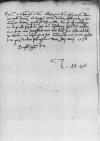Letter #3650
Tiedemann GIESE to Ioannes DANTISCUSs.l., 1538-05-16
| received [1538]-05-19 Manuscript sources:
| ||||
Text & apparatus & commentaryPlain textText & commentaryText & apparatus
Reverendissimo in Christo Patri et Domino, domino
Reverendissime in Christo Pater et Domine.
Aliis meis litteris oblitus sum addere exemplum litterarum ad
Commendo me amori Reverendissimae Dominationis Vestrae, quae valeat felicissime.
Datae XVI Maii 1538.
Eiusem Reverendisimae Dominationis Vestrae


 BCz, 1595, p. 1100
BCz, 1595, p. 1100